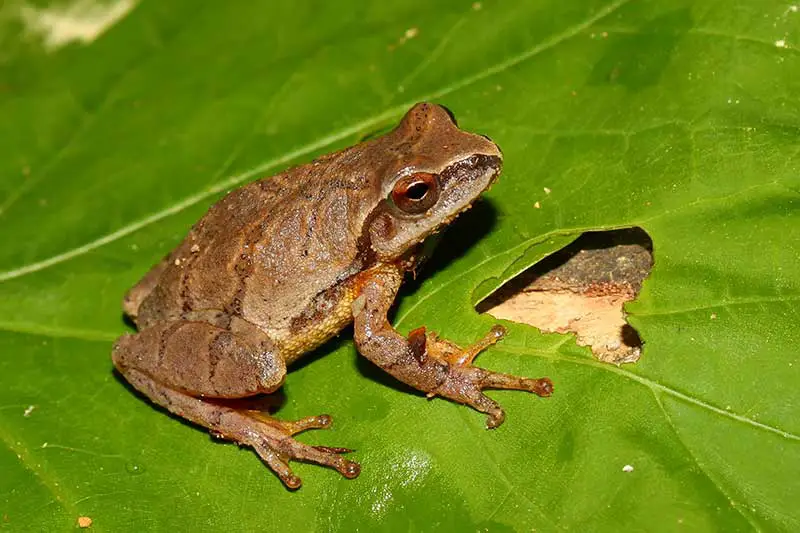Are there tree frogs in Illinois? There absolutely are. However, before we take a closer look at the state’s tree frogs, it’s important to understand exactly what a tree frog is.
By definition, a tree frog is any frog species that spends the majority of its lifespan in an arboreal state. What that means is that they live primarily in trees or other vegetation that is high-growing.
These frogs typically only descend to the ground to mate or spawn, where some species build foam nests on leaves. As adults, tree frogs rarely leave their arboreal habitat.
Keep reading to learn some interesting facts about the tree frogs in Illinois.
Types of tree frogs in Illinois
There are at least 23 species of frogs in the state of Illinois and we can identify 10 of those as being in the tree frog family.
The 10 species of tree frogs you’ll come across in Illinois are the spring peeper, green tree frog, gray tree frog, boreal chorus frog, Cope’s gray tree frog, western chorus frog, Blanchard’s cricket frog, bird-voiced tree frog, upland chorus frog, and the Illinois chorus frog.
1. Spring Peeper

Scientific name: Pseudacris crucifer
Spring peepers derive their name from the chirping calls you can hear them making at the beginning of spring every year. In Illinois and other northern states, the Northern spring peeper can be found in forests, woodlands, swamps, ponds, and marshes.
Small chorus frogs, these tiny frogs are only 1.5 inches (3.8 centimeters) and weigh less than five grams. Their colors range from brown to tan, although it’s not uncommon to see some that look gray or olive green. Spring peepers have a dark cross on the back.
During freezing winters, spring peepers hibernate behind bark and under logs to endure the cold. Notably, in Iowa, these tree frogs are considered threatened, underscoring the importance of conservation efforts for the Illinois tree frogs.
2. Gray Tree Frog

Scientific name: Dryophytes versicolor
Gray tree frogs are small frogs found throughout Illinois that can change their color from green to gray as needed for camouflage. Here’s a fun fact about gray tree frogs. Their color changes to match whatever surface they’re sitting on. Moreover, their mottling can vary from almost pure white to nearly black.
If you see gray tree frogs in an area that isn’t their normal habitat, they will be mostly gray in color. Their legs are patterned with dark bands.
These tree frogs live in forested areas and only descend to the ground to mate. It’s not unusual to see them around windows and porch lights where they can feast on insects.
3. Boreal Chorus Frog

Scientific name: Pseudacris maculata
You can find the boreal chorus frog throughout much of Canada and the United States. These frogs are tiny, growing to about three centimeters long. The calls they make are unique and each individual frog has its own pulses.
Boreal chorus frogs live near permanent bodies of water and the males make their calls from vegetation nearby. Every spring, these are typically the first amphibians you will hear making themselves known. They’re most common in Northern Illinois.
These tree frogs are brown in most cases, but can sometimes be observed as slightly green on their backs. They have three broken dorsal stripes that can be either distinct or faint.
4. Cope’s Gray Tree Frog
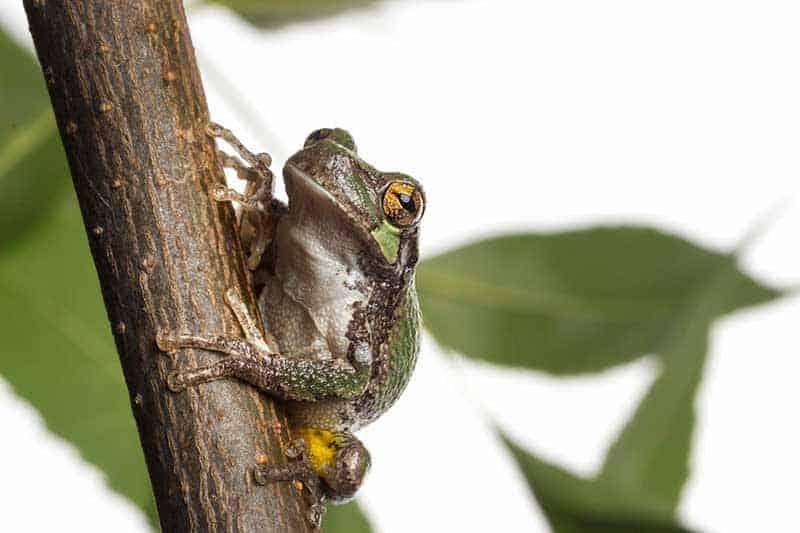
Scientific name: Dryophytes chrysoscelis
Frequently referred to as the Southern gray tree frog, Cope’s gray tree frogs share the same geographical area in Illinois as the gray tree frog and look identical to them. What differentiates the Cope’s gray tree frog is its higher-pitched and faster-paced call and this is the only difference between the two species.
In terms of habitat, the Cope’s gray tree frog lives in woodland areas and they move to ponds for breeding.
These frogs are primarily solitary frogs, but they do form choruses that allow them to call when they’re together. You can sometimes even hear these frogs responding to loud noises during the day.
5. Western Chorus Frog
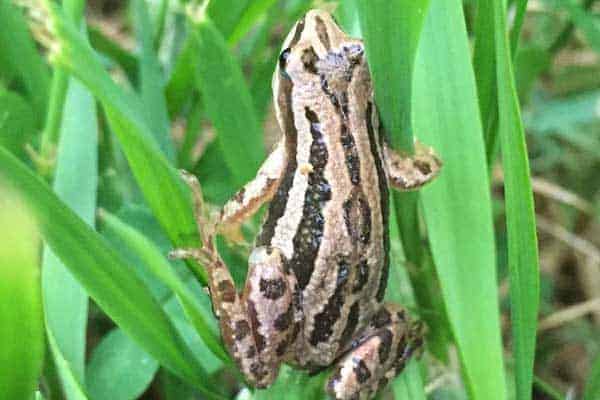
Scientific name: Pseudacris triseriata
Western chorus frogs are found throughout Illinois and are common in many parts of Canada and the U.S. These frogs grow to be about 1.6 inches (4 centimeters).
The color of Western chorus frogs is distinctive. They have three gray or dark brown stripes that run down their backs. However, the stripes can sometimes be missing or broken. On their upper lip, they have a white stripe, and a dark stripe can be seen on either side of their snouts across their eyes.
As with other species of tree frogs, the females tend to be larger than the males. You won’t often see these frogs. They are strictly nocturnal and tend to be secretive.
6. Green Tree Frog

Scientific name: Hyla cinerea
The green tree frog has a slender, smooth body that’s bright to dark green or grayish. Their sides are usually marked with a white stripe with a crisp black border. Adults grow to a size of 1 to 2.5 inches in length. Most adults have a few orange or yellow spots on their backs.
During the day they hide in shady areas or under vegetation surrounding water. At night they come out to catch flying insects. The green tree frog call, heard from April to September, is a nasal quoonk-quoonk repeated up to 75 times per minute. These frogs live throughout Florida.
Green tree frogs occur in extreme southern Illinois near the borders of Kentucky, Arkansas, and Tennessee.
7. Blanchard’s Cricket Frog
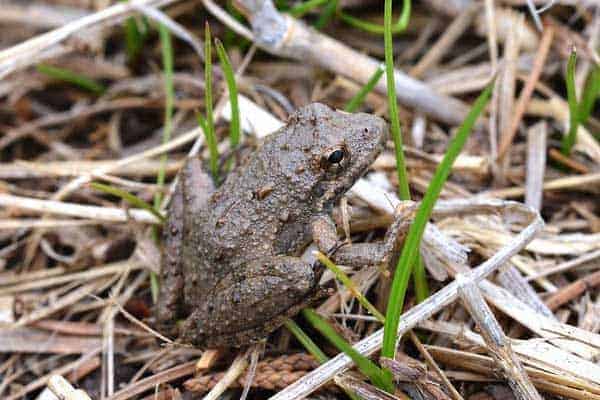
Scientific name: Acris blanchardi
The Blanchard’s Cricket frog is very small and found throughout Illinois. Adults grow up to 0.6 inches in length and their average lifespan is around one year only. Their skin is warty and brown, tan, gray, or olive green with dark bands on their legs.
These frogs can also easily get diseases as their skin is heavily vascularized, allowing substances to get into their bodies. You can find them throughout Texas except in the panhandle and western parts of the state.
8. Western Bird-Voiced Tree Frog
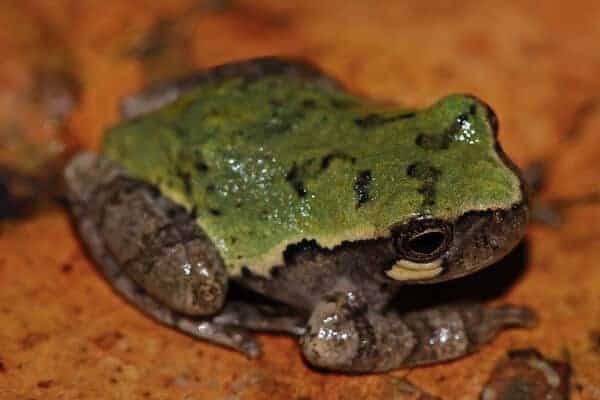
Scientific name: Hyla avivoca avivoca
The bird-voiced tree frog is typically 1 to 1.75 inches in length and is green, brown, or gray with dark blotches. They have a light spot under each eye which can vary in color. They spend most of their time in trees, only coming down to breed in shallow pools of swamps and creeks.
Their main diet is spiders and tree dwelling insects. The unusual name refers to their call, which is described as a birdlike whistle. You can hear them between April and September. In Floria, they are only found in the western end of the panhandle.
Like Blanchard’s cricket frog, this species is also present in extreme southern parts of the state.
9. Upland Chorus Frog

Scientific name: Pseudacris feriarum
The upland chorus frog can appear various shades of brown, with a dark brown stripe running along their side. Their throat and chest are often a light cream color, and they grow up to 1.4 inches in length.
Human activity doesn’t seem to scare them much, and they will inhabit small neighborhood ponds, flooded fields or roadside ditches. They like a moist, vegetated habitat near water, but spend very little time in the water itself. You will likely only see and hear them when breeding, and their most active breeding season is November through March.
The repetitive call of these frogs is sometimes described as sounding like running a finger along the teeth of a plastic comb. These frogs live in the forests of the Florida panhandle.
10. Illinois chorus frog
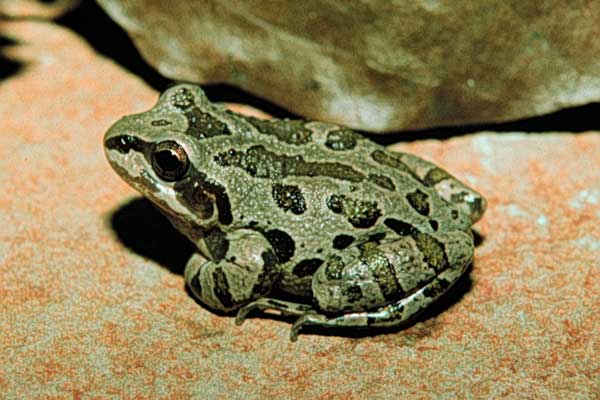
Last up on this list of tree frogs in Illinois is the Illinois chorus frog. They only have a very limited range in a small portion of Central Illinois as well as Southeastern Arkansas.
This little chorus frog can reach about 1.5 inches in length and adults are normally tan-gray in color. Illinois chorus frogs can be identified by a small diamond or triangle shaped pattern between their eyes.
You may also like: Do tree frogs make good pets?
